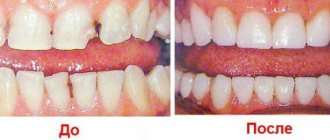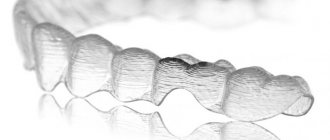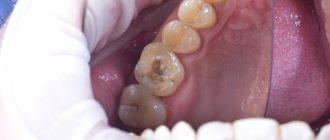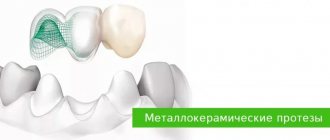As you know, most species of sharks completely change their teeth several times during their lives, and some of these dangerous predators manage to do this every few weeks. A person lives with one “set” all his life. At the same time, poor ecology, poor oral hygiene, unhealthy food, caries and other dental diseases do their job - they destroy our teeth. Fortunately, modern dentistry has a whole arsenal of tools for their restoration. Which ones exactly - says the chief physician, therapist and esthetician of the AktivStom clinic in Moscow, Yana Valentinovna Fedorova.
Teeth extension methods
Modern dentistry offers various methods and technologies for teeth extension. The choice of method depends on the patient’s financial capabilities and indications. Repairing a badly broken tooth will require such a drastic decision as installing a crown. A small chip can be corrected using composite materials. If a tooth has lost around 10–20% of tissue, then this is an indication for the installation of indirect ceramic veneers (provided that the patient does not suffer from tooth wear).
Example 9. Restoring the bottom six “from the root”
In this case, I would like to simply dwell on the moment of restoration itself. The patient is older, over 50 years old. And he felt the need to restore the chewing group of teeth. The picture shows the lower 6th tooth, of which practically only one root remains:
The tooth was restored in 1.5 hours
using Cerec technology. The very speed of tooth restoration in one visit to the doctor and the patient’s ability to immediately, as they say, use it in chewing gives a 100% head start on any existing method of tooth restoration. It works really well - you can see for yourself.
Example 10. Restoring the bottom seven
And I end my examples with the classic option of restoring the seventh lower tooth, of which only the root part remains. Removal of the lower 7th root of the tooth was not required; Cerec technology again proved to be excellent:
After modeling in 3D, manufacturing the module itself only took about 20 minutes, after which it was successfully installed on the remaining root:
Teeth extension using composite materials
Modern filling materials used for the restoration of front teeth harden only under the influence of the rays of a special lamp, most often an ultraviolet one. This gives the specialist the opportunity to carefully restore the natural shape of the damaged tooth. This is especially important when reconstructing large chips. However, after curing, the composite material becomes no less durable than a natural tooth, and if the doctor follows all standards and protocols, the junction of the enamel and the composite will not only be invisible, but also reliable - the tooth restored in this way will last for many years. However, it should be remembered that such restorations still have a service life and after 7 to 10 years they may require replacement.
How is front teeth augmentation done?
The front teeth are quite often subject to mechanical damage - chips and cracks form on them, and as a result of injuries, a significant part of the tooth can even break off. Also, the front teeth are susceptible to wear; if the problem is aggravated by a direct bite, then the wear becomes pathological. A special type of wear on the front incisors is horseshoe-shaped, which is often found among those who like to chew seeds. In addition, a common problem is gaps between the front teeth. In most such cases, functionality and aesthetics can be restored with the help of tooth augmentation with composite materials.
Another way to correct teeth in the smile area is to build teeth using veneers. These are thin plates attached to the front surface of the teeth. They perfectly imitate natural enamel in color and transparency, and do not add excessive thickness to the teeth. Veneers can be composite (made by a doctor directly in the patient’s mouth) and ceramic (made in a dental laboratory and glued to the teeth using special cement). This method of restoration is suitable in cases of thinning enamel, microcracks, and small chips. Also, extensions using ceramic and composite veneers help get rid of gaps between teeth - diastemas and threes, in cases where you can do without orthodontic treatment.
Prices
Free online consultation with a dentist
| Service | Price |
| Installation of core inlay (ceramic composite) | from 6,000 rub. |
| Installation of the stump inlay (cobalt-chrome) | from 6,300 rub. |
| Installation of a stump inlay made of bio-alloy (silver or gold, excluding the cost of the material) | from 6,300 rub. |
| Artistic restoration of the frontal group of teeth (1 tooth) | from 9,700 rub. |
| Installation of a core inlay based on zirconium dioxide (Zirkonzahn CAD/CAM technology Switzerland) | from 12,500 rub. |
| Installation of composite veneer | from 15,000 rub. |
| Installation of a metal-ceramic crown (Germany Ivoclar, cobalt-chrome) | from 15,000 rub. |
| Installation of restorative ceramic inlay E-max, Empress Esthetic (Germany) | from 16,500 rub. |
| Installation of a metal-free ceramic crown (Empress Esthetic, Germany) | from 25,000 rub. |
| Installation of a metal-ceramic crown based on a bio-alloy - gold (Ivoclar Germany + cost of material according to the certificate) | from 25,000 rub. |
| Installation of a ceramic crown based on zirconium dioxide (Zirkonzahn CAD/CAM technology Switzerland) | from 31,000 rub. |
| Installation of ceramic veneer E-max | from 28,000 rub. from 37,000 rub. promotion |
| Installation of ceramic veneer based on zirconium dioxide (Zirkonzahn CAD/CAM technology Switzerland) | from 32,000 rub. from 42,000 rub. promotion |
| Installation of ultra-thin ceramic veneer E-max | from 55,000 rub. |
| Installation of ultra-thin ceramic veneer SHOFU (Japan) | from 60,000 rub. |
Consultation and diagnostics are free!
All prices Promotions
Sign up for a consultation
three ROOTT specialists + diagnostics as a gift
Teeth extension with photopolymer
Another feature of composite materials that should not be forgotten is the degree of porosity, which exceeds the porosity of natural enamel. For the patient, this means two things: firstly, in the first few days after augmenting the front teeth with composite materials, you should refrain from consuming coloring foods and drinks, and every six months, when visiting a professional hygiene procedure, you need to pay special attention to the restorations, including the hygienist should polish them thoroughly. As for the external difference between the augmented areas of teeth and natural ones, thanks to modern methods for producing composites, the dentist has the opportunity to choose the color of the restoration to match the color of the patient’s enamel.
Proper care
Typically, the service life of such teeth is quite long, but it all depends on the quality of oral hygiene:
- Be sure to stop using a toothbrush with increased rigidity and not use abrasive toothpastes. They can cause damage to the extended part quite quickly;
- Try to give up bad habits - smoking, as well as excessive coffee consumption. Composite materials easily absorb all kinds of dyes;
- The material has a looser consistency, unlike natural enamel. Accordingly, deposits of plaque and stones occur faster on the artificial part. It is necessary to brush your teeth at least 2 times a day;
- Twice a year you should undergo preventive examinations with a dentist, who will carry out additional polishing and protective varnish.
Extension of chewing teeth
Chewing teeth are also often subject to destruction, in most cases the cause is caries. After treatment of caries, especially deep ones, large cavities remain, which the specialist fills with filling material after treatment. However, in some cases, only the root and a few thin walls may remain from the tooth, and sometimes even these remain. However, one of the trends in modern dentistry is the use of maximally tooth-preserving techniques. Therefore, if previously a healthy root that had lost its coronal part would most likely have been removed and a bridge-like prosthesis installed instead of the tooth, or, at best, an implant, today they prefer to preserve the root and restore the coronal part by installing an inlay and a crown.
Why removing the root is not the solution to the problem
If there is no natural crown, and instead of it an empty space appears, especially when it is the roots of the upper front teeth, many people habitually rush to the surgeon. They want to remove the remains and quickly install a bridge, eliminating the aesthetic defect.
But first, it’s worth considering the situation with your doctor - there are certain risks during removal: damage to the mandibular nerve, excessive trauma to the gums, and others. In addition, tooth restoration based on its own root is always more gentle than any prosthetic method.
Dentists try to preserve every unit, since the absence of natural teeth leads to a decrease in the quality of life. If you simply remove the roots of permanent teeth, then immediate implantation is needed. In the absence of a unit, destructive processes begin in tissues, and bone volume decreases. Therefore, doctors do not recommend neglecting this problem. Even if there is no chewing molar, which is not visible.
Tooth extension onto a pin
Some dentists still carry out tooth augmentation on a pin, which involves installing a metal rod (pin) directly into the root canal and layer-by-layer application of composite materials on it. Once upon a time, this method was a real breakthrough compared to conventional filling, as it made it possible to preserve the root and completely restore the tooth, even in cases where the coronal part was completely lost. However, subsequently, caries often formed around the pin, which provoked further tooth destruction and loss. Therefore, pins are a thing of the past, giving way to more reliable methods.
Correction with crowns
The installation of crowns as tooth extensions is also used in cases where the tooth is not destroyed, but is sufficiently damaged. Installing a crown is one of the effective ways to restore a broken tooth, this applies to both front and chewing teeth. Crowns are also used in cases where it is not possible to fill a chewing tooth, for example, because the cavity left after caries treatment is too large. This type of permanent prosthetics, such as crowns, is an ideal solution in cases where more than 70% of the crown part of the tooth is missing.
In modern aesthetic dentistry, ceramic and metal-ceramic crowns are successfully used. The installation process itself takes place in two stages. First, the doctor prepares the tooth (removes infected tissue, grinds down the walls), then an impression is taken, from which a crown for a chewing tooth or a crown for a front tooth is made in a dental laboratory. The second stage is the fitting and installation of the finished crown. Modern ceramics, used for the manufacture of inlays and crowns, make it possible to perfectly imitate the texture, color and transparency of natural enamel, as well as select a shade in accordance with the color of neighboring teeth.
Alternatives
There are clinical cases when it is impossible to restore a tooth. If half of the tooth or the entire crown part is destroyed, a crown is already needed. The root is damaged - you have to choose between:
- Implantation
A metal pin – an implant – is screwed into place of the removed root. A crown is put on it. Neighboring teeth are not involved. The implant performs the functions of a natural root. It comes with a lifetime warranty
.
- Bridge prosthesis
The artificial tooth is located between two crowns. Load-bearing teeth are ground down for crowns. Does not prevent bone loss. Should be changed every 5-7 years
.
Indications and contraindications
Depending on the chosen method of teeth extension, indications and contraindications for each specific technique should be determined by your dentist. In this situation, you should not be guided solely by your taste preferences. Otherwise, your uncompromising demand: “I want veneers!” may lead to the fact that the treatment will not bring the desired effect, and the money will be wasted. Don't forget: everything is individual. For example, extensions using photopolymers are not practiced if there is severe tooth mobility. It is also recommended to avoid veneering for those patients who suffer from periodontal disease or do not have the necessary dental hygiene skills.
Main indications for extensions
- Cracks and chips
Microdamages caused by trauma. - Damage to the crown
If the dental crown is deformed or broken. - Consequences of caries
In case of advanced caries, when the tooth root is intact, but the area for filling is too large. - Gaps between teeth
Diastema, which negatively affects aesthetics. - Changing the color of the enamel A
dental defect such as fluorosis - white spots on the surface of the tooth enamel - cannot be eliminated with whitening, but can be corrected with extensions. - Increased tooth abrasion
As a result of demineralization of tooth enamel or a hereditary factor. - Malocclusion
Effective for mild defects in the occlusion of the dentition.
Absolute contraindications to extensions
- Maximum damage to the tooth
If the tooth is destroyed by more than 30%, the extension will not give a positive result. - Allergy
An allergic reaction to individual components of filling materials is rare, but its presence makes extension impossible. - Bruxism
Night and daytime teeth grinding will definitely lead to the destruction of the extended tooth. - Unsuccessful tooth localization
If the tooth is located in such a way that it cannot be isolated from saliva during the procedure, which neutralizes its result.
Make an appointment
right now!
Fedorova Yana Valentinovna
Therapist, Hygienist
Artificial fangs
Absolutely any type of extension performs exclusively the function of beauty. Any careless movement or eating hard foods can lead to the material peeling off or the crown falling out. A similar manipulation can be carried out in any dentistry in your city.
We should not forget that when growing a fang by more than 4 mm, severe harm to health can be caused. Such fangs can injure the gingival surface, causing inflammation and irritation of the mucous membranes of the mouth. Poor chewing of food often leads to problems with the digestive tract, as well as to the formation of duodenal ulcers, because eating with fangs is extremely inconvenient and it is impossible to chew food thoroughly with them.
Be very attentive to the extended fangs, as with any sudden movement there is a risk of breaking the entire tooth, which can lead to the subsequent removal of the injured tooth and the placement of dentures.
How much does tooth augmentation cost?
If we mean tooth extension in the smile zone, then the cost of restoration with composite materials will range from 2,500 rubles to 15,000 rubles per tooth in economy and premium class clinics, respectively. The price of installing ceramic veneers starts from 20,000 per tooth in economic dentistry, and in a VIP clinic the price can reach up to 50,000 rubles per plate. The price for extension of chewing teeth consists of the cost of an inlay, a dental crown on it and the work of an orthopedic dentist, which will cost on average from 10,000 rubles to 50,000 rubles, depending on the materials used and the price segment of the clinic.
Publisher: Expert magazine about dentistry Startsmile.ru
Advantages of the RUTT clinic
In Moscow, restoration is carried out in almost all clinics. It is important to choose one that does it well.
IN ICDI ROOTT:
- Modern composite materials
are used . They are less susceptible to shrinkage and cracks, wear-resistant and durable. - It has its own technical laboratory
. You won’t have to overpay intermediaries and production times will be shorter. - Reception is conducted by qualified doctors who are constantly learning. All new methods are immediately put into practice.
- Customer support service
is available . Any question will be answered there.
All consultations at the clinic are free of charge.
.










